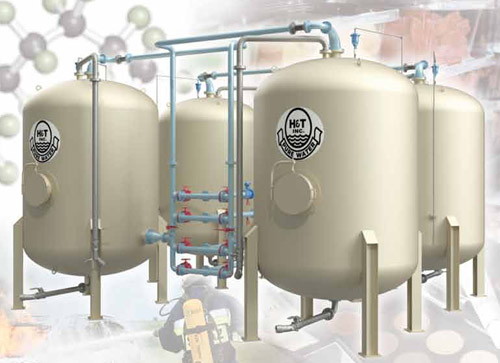Advanced Techniques for Effective PFAS Contamination Elimination
The relentless difficulty of PFAS contamination requires the expedition of sophisticated elimination methods that can efficiently address these damaging substances. Innovative modern technologies, such as innovative oxidation processes and numerous adsorption strategies, have actually emerged as appealing options in mitigating PFAS from affected environments.
Recognizing PFAS Qualities
Although per- and polyfluoroalkyl materials (PFAS) have been extensively utilized in various industrial and consumer products due to their special properties, their persistence in the setting positions significant obstacles to public health and wellness and security. PFAS are a team of artificial chemicals defined by a carbon-fluorine bond, one of the best chemical bonds understood, which adds to their outstanding security and resistance to degradation. This security permits PFAS to build up in the environment and living organisms, leading to potential damaging health impacts.
These exact same properties contribute to their environmental determination, as PFAS do not quickly break down with natural processes. Understanding the chemical buildings of PFAS is important for establishing efficient techniques to handle and alleviate their environmental impact.
Innovative Removal Technologies
The perseverance of PFAS in the setting has actually stimulated the development of cutting-edge removal innovations focused on efficiently eliminating these contaminants from affected ecosystems. Amongst one of the most appealing methods are innovative oxidation procedures (AOPs), which make use of effective oxidants to break down PFAS substances right into less harmful materials. AOPs can be customized to target details PFAS structures, boosting their effectiveness.
Another arising innovation is using adsorption media, such as turned on carbon and ion exchange materials, which can uniquely catch PFAS from contaminated water. These products have revealed considerable removal performances, although regular replacement and regrowth are needed to maintain efficiency.
Membrane layer filtration techniques, including reverse osmosis and nanofiltration, are also getting traction in PFAS removal. These methods can properly separate PFAS from water, giving a feasible solution for dealing with contaminated sources. In addition, thermal treatment approaches, such as incineration, can break down PFAS right into non-toxic by-products, though they require cautious monitoring to regulate emissions.
Collectively, these cutting-edge remediation innovations represent considerable developments in the recurring battle against PFAS contamination, using various techniques to recover damaged environments and secure public wellness.

Bioremediation Methods
Bioremediation strategies supply an encouraging technique to dealing with PFAS contamination by using the natural capabilities of bacteria to degrade these relentless compounds (m270 waste management). This approach includes the usage of germs, fungis, and other germs that can metabolize or transform PFAS compounds into less unsafe by-products
Current developments in molecular biology and ecological microbiology have improved our understanding of microbial areas and their potential roles in PFAS destruction. Researchers are actively discovering specific stress of bacteria, such as Pseudomonas and Bacillus, which have shown the capacity to break down specific PFAS substances.
Sitting bioremediation techniques, where microbes are boosted directly in polluted settings, can be particularly reliable. This strategy typically entails the application of nutrients or electron contributors to promote microbial development and task. Additionally, ex situ approaches, such as bioreactors, enable regulated problems that can optimize deterioration prices.
Regardless of the assurance of bioremediation, challenges stay, consisting of the complicated nature of PFAS substances and the demand for extensive field testing - m270 waste management. Continued r & d will certainly be crucial to refine these methods and evaluate their efficiency in varied environmental contexts
Adsorption and Filtering Methods
Dealing with PFAS contamination typically includes utilizing adsorption and filtering techniques, which are developed to remove these persistent chemicals from water and soil. Among the numerous strategies, turned on carbon adsorption is extensively used because of its high surface and porosity, making it possible for reliable trapping of PFAS molecules. Granular activated carbon (GAC) systems are particularly preferred for dealing with big volumes of contaminated water, while powdered activated carbon (PAC) can be utilized for smaller-scale applications.
Ion exchange resins also reveal pledge in PFAS removal, functioning by trading PFAS ions with less hazardous ions in the water. This method has demonstrated effectiveness in concentrating PFAS compounds, promoting their succeeding removal. Additionally, membrane filtration strategies, such as reverse osmosis and nanofiltration, operate by utilizing semi-permeable membrane layers to separate PFAS from water, effectively lowering their look at this now focus.
While these approaches work, they should be carefully picked based on the details PFAS compounds existing and the environmental context. Continual improvements this link in materials scientific research and engineering are bring about the development of unique adsorbents and filtration systems that improve removal effectiveness and lower functional costs, consequently improving general removal efforts.
Regulatory and Policy Factors To Consider
How can efficient governing frameworks improve the management of PFAS contamination? Extensive plans are important to make certain a coordinated and robust reaction to the obstacles posed by per- and polyfluoroalkyl compounds (PFAS) Rules can develop clear guidelines for tracking, reporting, and remediating PFAS-contaminated websites, cultivating accountability among industries and public entities. (m270 waste management)

On top of that, financial rewards and gives can be incorporated into policies to motivate the adoption of sophisticated removal technologies. Policymakers must additionally focus on r & d, making sure that arising approaches for PFAS elimination are validated and carried out effectively.
In addition, public understanding and link interaction are crucial elements of any kind of governing approach, encouraging communities to advocate for their health and safety. Ultimately, a well-structured regulatory environment will certainly not just boost the monitoring of PFAS contamination but additionally advertise lasting techniques that shield future generations.
Verdict
In recap, the complexity of PFAS contamination demands the fostering of sophisticated remediation approaches. Proceeded study and development in this area continue to be essential to dealing with the difficulties presented by PFAS contamination.